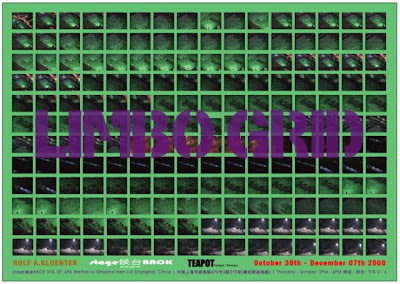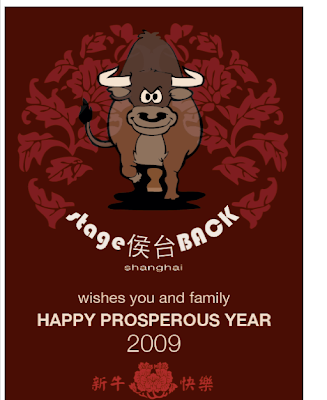January 24, 2009
January 15, 2009
January 6, 2009
New New New!!!
FINALLY!
We are present on the web.
After weeks and weeks of hassling with a web site designer,
we decided to do it on our own and write a blog about us, our artists, and art events in Shanghai.
Happy New Year 2009!
Participate and write to us.
If you are an artist, send us work.
I want to send a message beyond Shanghai and create interest on people all over the world towards our crazy city and its intense vibes.
Happy New Year 2009!
Geiles Globales Gesicht @ #1 Art Museum Shanghai China





I was invited to participate in a group show together with Tan Gengxiong last December. It was held at the #1 Art Museum in Shanghai, 1 Jianguo Rd. This event also being covered on citybeat
ICS TV - city beats - @ Limbo Grid





stage候台BACK had its first TV appearance last month covering Rolf A. Kluenters Limbo Grid in a 6 Minute feature. Check out the video on_site
Limbo Grid - press release




Limbo Grid film stills
"Limbo Grid"过渡状态
film and installation
摄像与布景
In his installation Limbo Grid, Rolf A. Kluenter sets a film projection, which documents a variety of nightshift scenes at central Shanghai's construction sites, against a net-like structure made of the fragile blackened Nepalese handmade paper that hangs down from the ceiling and divides the space into two rooms.
Rolf A. Kluenter在"过渡状态"的布景中设置了幻灯片,幻灯片中记录着上海市中心变换多样的工地夜班场景; 尼泊尔手工制作的黑色脆纸构建成的网状结构,由天花板垂落下来的, 将空间分隔成两个房间。
The space of stage候台BACK at 696 Weihai Road invites the visitor to walk through the installation, watching the film, feeling the structure and experiencing the blackness. This might be Kluenter's intended process, which inextricably interweaves transparency and denseness; fragility and strength.
展览地点位于威海路696号, stage候台BACK 诚邀来访者步入整个布景,观看摄影/影片,亲身感受建筑结构,体验黑暗状态。这或许就是艺术家Kluenter的创作本意所在 :无法摆脱地交织着透明与稠密,脆弱与坚强。
A Limbo is a space that is between two places. It is a place or state of oblivion to which persons or things are regarded as being relegated when cast aside, forgotten, past, or out of date. Spiritually and in scholastic theology, limbo is an extramundane region where certain classes of souls were supposed to await their judgment.
Limbo 意为两处中间的位置,常被理解为被漠视的处所或状态。 当事物或人结束,被搁置,遗忘,或者过时, 这里便是他们的归宿。从精神层面上以学术的理论探究, Limbo 是超越现实世界的地带,各种灵魂将在这里等待着对他们的最终宣判。
With the exhibition Limbo Grid, stage候台BACK proudly announces the soft opening of the future collaboration between stage候台BACK Shanghai 696 and TEAPOT Gallery, from Cologne in Germany. stage候台BACK自豪地宣布LIMBO GRID展览将成为上海 stage候台BACK 与德国科隆的 TEAPOT Gallery 之间未来协作的软开幕。
film and installation
摄像与布景
In his installation Limbo Grid, Rolf A. Kluenter sets a film projection, which documents a variety of nightshift scenes at central Shanghai's construction sites, against a net-like structure made of the fragile blackened Nepalese handmade paper that hangs down from the ceiling and divides the space into two rooms.
Rolf A. Kluenter在"过渡状态"的布景中设置了幻灯片,幻灯片中记录着上海市中心变换多样的工地夜班场景; 尼泊尔手工制作的黑色脆纸构建成的网状结构,由天花板垂落下来的, 将空间分隔成两个房间。
The space of stage候台BACK at 696 Weihai Road invites the visitor to walk through the installation, watching the film, feeling the structure and experiencing the blackness. This might be Kluenter's intended process, which inextricably interweaves transparency and denseness; fragility and strength.
展览地点位于威海路696号, stage候台BACK 诚邀来访者步入整个布景,观看摄影/影片,亲身感受建筑结构,体验黑暗状态。这或许就是艺术家Kluenter的创作本意所在 :无法摆脱地交织着透明与稠密,脆弱与坚强。
A Limbo is a space that is between two places. It is a place or state of oblivion to which persons or things are regarded as being relegated when cast aside, forgotten, past, or out of date. Spiritually and in scholastic theology, limbo is an extramundane region where certain classes of souls were supposed to await their judgment.
Limbo 意为两处中间的位置,常被理解为被漠视的处所或状态。 当事物或人结束,被搁置,遗忘,或者过时, 这里便是他们的归宿。从精神层面上以学术的理论探究, Limbo 是超越现实世界的地带,各种灵魂将在这里等待着对他们的最终宣判。
With the exhibition Limbo Grid, stage候台BACK proudly announces the soft opening of the future collaboration between stage候台BACK Shanghai 696 and TEAPOT Gallery, from Cologne in Germany. stage候台BACK自豪地宣布LIMBO GRID展览将成为上海 stage候台BACK 与德国科隆的 TEAPOT Gallery 之间未来协作的软开幕。
Rolf A. Kluenter, Limbo Grid, mixed media + film, 2008 A site-specific installation created for stage候台BACK, Shanghai, October 30 – December 7, 2008

Limbo Grid provides an insight into Kluenter’s cosmology and his observation of urbanity as an awe-inspiring reality. These aspects of Kluenter’s aesthetics might bear strong reminiscences of scenes and atmospheres of 19th century Romanticism. In contrast, however, his recourses and references rather relate to the “Darkness” of a mega-urban scenario than to the “Mighty of Nature”.
In his installation, a multi-layered net-like structure metaphorically plays the central role. The net-like structure is made of fragile blackened Nepalese handmade paper. It hangs down from the ceiling and divides the space into two rooms. As a contra-point to the dominant black paper-structure, a film projection is set on the opposite wall. The short film is based on a variety of nightshift scenes which Kluenter filmed during the past years at one of central Shanghai’s many construction sites. The film music is composed of several commonly known sound-fragments that Kluenter has re-arranged and re-mixed to enhance the scenes of the film.
Tiny objects that are attached to the lower and upper ends of the blackened paper grid further alienate the work. A very small staircase made of Lego-toys comes forth from the lower end and reaches to the ground where small plastic toy-puppets stand to welcome the descendants. A welcome banner reads: “Welcome back from Limbo. Welcome to our brave new world”. From the upper end of the paper-grid, joined plastic drinking straws emerge and extend into space as a loop. Attached to the plastic drinking straw structure, black scrolls are hanging down on which a variety of statements are written that relate to the term “heaven”. During the exhibition period until December 7, Kluenter will be adding one statement on “heaven” on each day.
Since the installation and film figuratively evoke a state of non-resolution and uncertainty, the connotation of a “Limbo”, a term that has been frequently used in literature, becomes obvious. Limbo is a place or state of oblivion to which persons or things are regarded as being relegated when cast aside, forgotten, past, or out of date. Spiritually and in scholastic theology, limbo is an extramundane region where certain classes of souls were supposed to await their judgment.
Blackened Nepalese paper has been the primary ground and substance of Rolf A. Kluenter’s work for the past years. Blackness essentially suggests the absence of a source of light and the notion of void. Its nature evokes the limits of the visible. The hand-made structures of the blackened Nepalese net-like paper object show an excessive load of irregularities.
Like an ongoing experiment, Kluenter’s approach is to display his works in series as ever so many declinations of basic emotional positions. Life and art are situated between cultures, crossing borders, intersecting at cross-cultural pathways: process of change, fluctuation and spatial-geographic traceless-ness, interdisciplinary paradoxes, wordless and non-conceptual messages simulating unlimited virtual variety.
Subscribe to:
Comments (Atom)

















